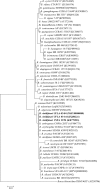Classification of the inoculant strain of cowpea UFLA03-84 and of other strains from soils of the Amazon region as Bradyrhizobium viridifuturi (symbiovar tropici)
- PMID: 30759310
- PMCID: PMC6863273
- DOI: 10.1007/s42770-019-00045-x
Classification of the inoculant strain of cowpea UFLA03-84 and of other strains from soils of the Amazon region as Bradyrhizobium viridifuturi (symbiovar tropici)
Abstract
Cowpea (Vigna unguiculata L.) is a legume species that considerably benefits from inoculation with nitrogen fixing bacteria of the genus Bradyrhizobium. One of the strains recommended for inoculation in cowpea in Brazil is UFLA03-84 (Bradyrhizobium sp.). The aim of our study was to define the taxonomic position of the UFLA03-84 strain and of two other strains of Bradyrhizobium (UFLA03-144 and INPA237B), all belonging to the same phylogenetic group and isolated from soils of the Brazilian Amazon. Multilocus sequence analysis (MLSA) of the housekeeping genes atpD, gyrB, recA, and rpoB grouped (with similarity higher than 99%) the three strains with Bradyrhizobium viridifuturi SEMIA 690T. The analyses of average nucleotide identity and digital DNA-DNA hybridization supported classification of the group as Bradyrhizobium viridifuturi. The three strains exhibited similar behavior in relation to the most of the phenotypic characteristics evaluated. However, some characteristics exhibited variation, indicating phenotypic diversity within the species. Phylogenetic analysis of the nodC and nifH genes showed that the three strains are members of the same symbiovar (tropici) that contains type strains of Bradyrhizobium species coming from tropical soils (SEMIA 690TB. viridifuturi, CNPSo 1112TB. tropiciagri, CNPSo 2833TB. embrapense, and B. brasilense UFLA03-321T).
Keywords: Average nucleotide identity; Bradyrhizobium; Genome; Housekeeping genes; Vigna unguiculata L..
Conflict of interest statement
The authors declare that they have no conflict of interest.
Figures




Similar articles
-
Bradyrhizobium brasilense sp. nov., a symbiotic nitrogen-fixing bacterium isolated from Brazilian tropical soils.Arch Microbiol. 2017 Oct;199(8):1211-1221. doi: 10.1007/s00203-017-1390-1. Epub 2017 May 27. Arch Microbiol. 2017. PMID: 28551732
-
Bradyrhizobium uaiense sp. nov., a new highly efficient cowpea symbiont.Arch Microbiol. 2020 Jul;202(5):1135-1141. doi: 10.1007/s00203-020-01827-w. Epub 2020 Feb 15. Arch Microbiol. 2020. PMID: 32062690
-
Efficient Nitrogen-Fixing Bacteria Isolated from Soybean Nodules in the Semi-arid Region of Northeast Brazil are Classified as Bradyrhizobium brasilense (Symbiovar Sojae).Curr Microbiol. 2020 Aug;77(8):1746-1755. doi: 10.1007/s00284-020-01993-6. Epub 2020 Apr 22. Curr Microbiol. 2020. PMID: 32322907
-
Bradyrhizobium centrosemae (symbiovar centrosemae) sp. nov., Bradyrhizobium americanum (symbiovar phaseolarum) sp. nov. and a new symbiovar (tropici) of Bradyrhizobium viridifuturi establish symbiosis with Centrosema species native to America.Syst Appl Microbiol. 2016 Sep;39(6):378-83. doi: 10.1016/j.syapm.2016.06.001. Epub 2016 Jun 17. Syst Appl Microbiol. 2016. PMID: 27394069
-
Bradyrhizobium mercantei sp. nov., a nitrogen-fixing symbiont isolated from nodules of Deguelia costata (syn. Lonchocarpus costatus).Int J Syst Evol Microbiol. 2017 Jun;67(6):1827-1834. doi: 10.1099/ijsem.0.001870. Epub 2017 Jun 22. Int J Syst Evol Microbiol. 2017. PMID: 28639930
Cited by
-
Contribution of Biofertilizers to Pulse Crops: From Single-Strain Inoculants to New Technologies Based on Microbiomes Strategies.Plants (Basel). 2023 Feb 20;12(4):954. doi: 10.3390/plants12040954. Plants (Basel). 2023. PMID: 36840302 Free PMC article. Review.
-
Polyphasic analysis reveals correlation between phenotypic and genotypic analysis in soybean bradyrhizobia (Bradyrhizobium spp.).Syst Appl Microbiol. 2020 May;43(3):126073. doi: 10.1016/j.syapm.2020.126073. Epub 2020 Feb 15. Syst Appl Microbiol. 2020. PMID: 32139173 Free PMC article.
-
Bradyrhizobium tunisiense sp. nov., a novel rhizobial species isolated from Acacia saligna nodules.Int J Syst Evol Microbiol. 2025 Jun;75(6):006807. doi: 10.1099/ijsem.0.006807. Int J Syst Evol Microbiol. 2025. PMID: 40536800 Free PMC article.
-
A Genomotaxonomy View of the Bradyrhizobium Genus.Front Microbiol. 2019 Jun 13;10:1334. doi: 10.3389/fmicb.2019.01334. eCollection 2019. Front Microbiol. 2019. PMID: 31263459 Free PMC article.
-
Evaluation of Cowpea Landraces under a Mediterranean Climate.Plants (Basel). 2023 May 10;12(10):1947. doi: 10.3390/plants12101947. Plants (Basel). 2023. PMID: 37653864 Free PMC article.
References
-
- Guimarães AA, Jaramillo PMD, Nóbrega RSA, Florentino LA, Silva KB, Moreira FMS. Genetic and symbiotic diversity of nitrogen-fixing bacteria isolated from agricultural soils in the western Amazon by using cowpea as the trap plant. Appl Environ Microbiol. 2012;78(18):6726–6733. doi: 10.1128/AEM.01303-12. - DOI - PMC - PubMed
-
- Jaramillo PMD, Guimarães AA, Florentino LA, Silva KB, Nóbrega RSA, Moreira FMS. Symbiotic nitrogen-fixing bacterial populations trapped from soils under agroforestry systems. Sci Agric. 2013;70(6):397–404. doi: 10.1590/S0103-90162013000600004. - DOI
-
- Rufini M, Silva MAP, Ferreira PAA, Cassetari AS, Soares BL, Andrade MJB, Moreira FMS. Symbiotic efficiency and identification of rhizobia that nodulate cowpea in a Rhodic Eutrudox. Biol Fertil Soils. 2014;50(1):115–122. doi: 10.1007/s00374-013-0832-4. - DOI
MeSH terms
Substances
LinkOut - more resources
Full Text Sources
Molecular Biology Databases

